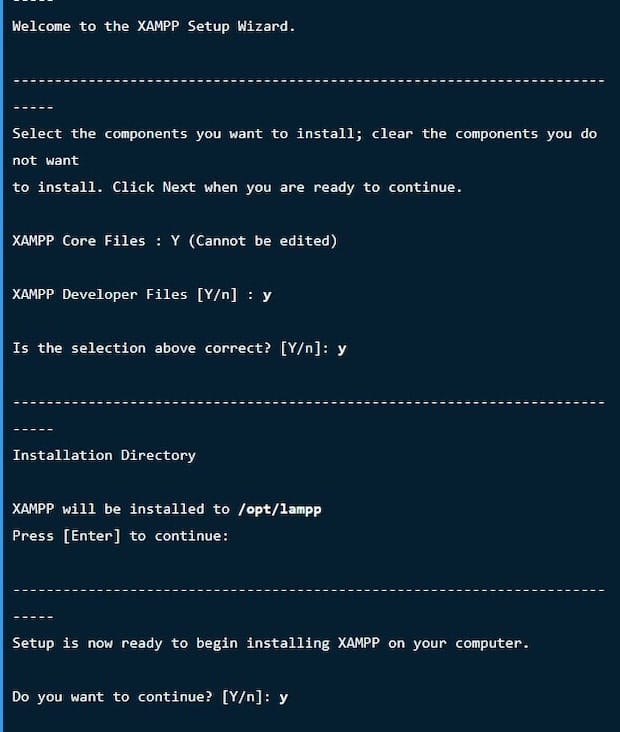How To Install XAMPP on Rocky Linux 9

In this tutorial, we will show you how to install XAMPP on Rocky Linux 9. For those of you who didn’t know, XAMPP (Cross-platform, Apache, MySQL, PHP, and Perl) is a popular software package that provides an all-in-one solution for setting up a local server stack.
This article assumes you have at least basic knowledge of Linux, know how to use the shell, and most importantly, you host your site on your own VPS. The installation is quite simple and assumes you are running in the root account, if not you may need to add ‘sudo‘ to the commands to get root privileges. I will show you the step-by-step installation of the XAMPP on Rocky Linux 9 or RHEL-based.
Key features and components of XAMPP
- Apache HTTP Server: The Apache web server is a powerful and widely used server software that delivers web content to clients.
- MySQL Database: MySQL is a popular relational database management system that enables the storage and retrieval of data for web applications.
- PHP: PHP is a server-side scripting language used for developing dynamic web pages and web applications.
- Perl: Perl is a high-level programming language that is commonly used for web development and system administration.
Prerequisites
- A server running one of the following operating systems: Rocky Linux 9.
- It’s recommended that you use a fresh OS install to prevent any potential issues.
- SSH access to the server (or just open Terminal if you’re on a desktop).
- An active internet connection. You’ll need an internet connection to download the necessary packages and dependencies for XAMPP.
- A
non-root sudo useror access to theroot user. We recommend acting as anon-root sudo user, however, as you can harm your system if you’re not careful when acting as the root.
Install XAMPP on Rocky Linux 9
Step 1. The first step is to update your system to the latest version of the package list. To do so, run the following commands:
sudo dnf update
Step 2. Installing XAMPP on Rocky Linux 9.
Now open your web browser and navigate to the official XAMPP website and click on the “Download” button, and you will be redirected to the download page:
https://sourceforge.net/projects/xampp/files/XAMPP%20Linux/8.2.4/xampp-linux-x64-8.2.4-0-installer.run
Navigate to the directory where the XAMPP package was downloaded using the cd command and run the following command to download the MD5 checksum file for the XAMPP package:
wget https://www.apachefriends.org/xampp-files/<version>/md5sums.txt
Replace <version> with the version number of the downloaded XAMPP package.
Verify the integrity of the downloaded package by comparing the MD5 checksum of the package with the one provided in the md5sums.txt file. Use the following command:
md5sum -c md5sums.txt
Next, grant execute permissions to the installation script by running the following command:
sudo chmod +x xampp-linux-x64-8.2.4-0-installer.run
Now execute the XAMPP installation script with administrative privileges using the following command below:
sudo ./xampp-linux-x64-8.2.4-0-installer.run
The setup wizard will be Text-based, just follow or see the below screenshot to get an idea:

Step 3. Start XAMPP Server.
Once the installation is complete, you will see a confirmation message in the terminal. To configure XAMPP to start automatically at boot, run the following command:
sudo /opt/lampp/lampp start
Step 4. Testing the XAMPP Installation.
By default, the Apache web server is the only component that is active. Open your web browser and enter the following URL:
http://localhost
If you see the XAMPP dashboard, it means Apache is running.
To check the status of the MySQL service, enter the following URL:
http://localhost/phpmyadmin
Step 4. Troubleshooting Common Installation Issues.
Sometimes, you may encounter issues during the installation process. Here are some troubleshooting tips for common problems:
A. Addressing permission-related errors:
- Ensure that you are running the installation script with administrative privileges using the
sudocommand. - Double-check the file permissions for the XAMPP package and the installation script.
B. Dealing with conflicting ports:
- If you encounter port conflicts, you can modify the default ports used by Apache and MySQL in the XAMPP configuration file located at
/opt/lampp/etc/httpd.conffor Apache and/opt/lampp/etc/my.cnffor MySQL.
C. Resolving potential service conflicts:
- If you have other web servers or database services running on your system, make sure to stop them before installing XAMPP to avoid conflicts.
Congratulations! You have successfully installed XAMPP. Thanks for using this tutorial for installing XAMPP on your Rocky Linux 9 system. For additional help or useful information, we recommend you check the official XAMPP website.